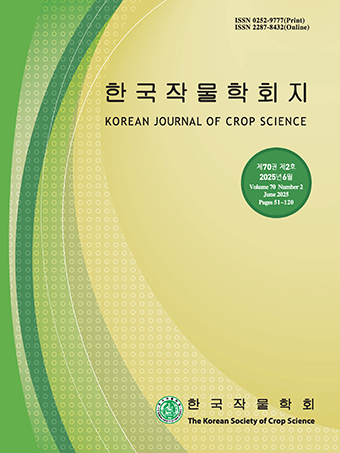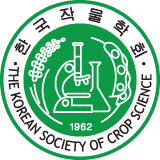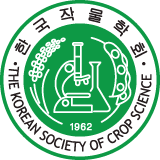-
Original Research Article

-
Analysis of Changes in Rice Heading Dates Using Deep Learning-Based Temperature Prediction
딥러닝 기반 기온예측에 따른 벼 출수기 변화 분석
-
Sung Kook Kim, Seung-Hwan Kang
김성국, 강승환
- Rice is one of the world’s three major staple crops and serves as a primary food source for over half of the …
- Rice is one of the world’s three major staple crops and serves as a primary food source for over half of the global population. Accurately diagnosing the growth stages of rice is essential for effective growth management. In particular, the heading date is influenced significantly not only by genetic factors but also by environmental factors such as temperature. Moreover, recent climate changes have increased the interannual variation in heading dates, making precise cultivation management more challenging. This study analyzes and predicts the heading date of Ilpum rice, a variety commonly cultivated in Jeongeup City, using deep learning techniques. The deep learning model employed is a gated recurrent unit (GRU) model. To reflect the time-series characteristics of the data, time-related variables are extracted and normalized. The model’s generalization performance and learning efficiency are enhanced with GRU layers, Dropout, and Batch Normalization. For optimization, techniques such as EarlyStopping and learning rate adjustment are applied to ensure stable and efficient training. The predicted temperature range for 2025 to 2034 is estimated to be between 27.46°C and 30.59°C, which is either within or close to the previous temperature range, suggesting relative stability in temperature during this period. When calculating the slope of the trend line, the equation is y=0.083x-139, indicating an annual temperature increase of approximately 0.08°C. While this may lead to long-term temperature increases, the predicted temperature range suggests that heading dates of rice will not undergo significant changes from 2025 to 2034. Additionally, this study demonstrates that time-series analysis and future temperature predictions can provide valuable insights for crop growth. Beyond predicting rice heading dates, this approach can be extended to various analyses, showcasing the potential of deep learning techniques in agriculture. - COLLAPSE
-
Analysis of Changes in Rice Heading Dates Using Deep Learning-Based Temperature Prediction
-
Original Research Article

-
Rice Leaf Area Index Evaluation Using RGB-based Vegetation Indices and Machine Learning Models
RGB 기반 생육지수와 기계학습 모델을 활용한 벼 엽면적지수 평가
-
Eun-ji Kim, Hyeok-jin Bak, Dongwon Kwon, Sungyul Chang, Woo-jin Im, Nam-jin Chung, Jae-Ki Chang, Woon-Ha Hwang, Wan-Gyu Sang
김은지, 박혁진, 권동원, 장성율, 임우진, 정남진, 장재기, 황운하, 상완규
- Recently, the agricultural sector has embraced digital technologies to improve crop growth monitoring, aiming to boost efficiency and reduce labor. In rice, …
- Recently, the agricultural sector has embraced digital technologies to improve crop growth monitoring, aiming to boost efficiency and reduce labor. In rice, leaf area is closely related to photosynthesis and yield. However, traditional measurements tend to be destructive and LAI-based methods could be costly or constrained by environmental factors. To address this problem, two medium-late rice cultivars were grown, and nadir RGB images were acquired from tillering to panicle initiation. Seven vegetation indices were derived from the R, G, and B channels, and Otsu’s algorithm was used to segment rice from the background. Various machine learning models (e.g., Random Forest and eXtreme Gradient Boosting), followed by the predicted leaf area index, validated by destructive (LI-3100) and LAI measurements. During tillering, both index-based and machine learning methods surpassed 0.98 classification accuracy, with ExG, MExG, and CIVE strongly correlating with the measured leaf area. However, leaf morphology changes and shading after panicle initiation reduced accuracy, although the actual leaf area comparisons remained more reliable than LAI. Taken together, this study demonstrates the usefulness of RGB imagery for rapid and non-destructive rice growth assessment and highlights its potential for real-time field monitoring and automated precision agriculture. - COLLAPSE
-
Rice Leaf Area Index Evaluation Using RGB-based Vegetation Indices and Machine Learning Models
-
Original Research Article

- Optimized Deep Learning Model for Soybean Leaf Classification in Complex Field Environments
- Jiwoo Kang, Taehwan Shin, Jonghan Ko
- Accurate and efficient monitoring of soybean crops is crucial to ensure a stable yield and improved quality. Traditional manual monitoring methods are …
- Accurate and efficient monitoring of soybean crops is crucial to ensure a stable yield and improved quality. Traditional manual monitoring methods are labor-intensive and time consuming, highlighting the need for automated solutions. Deep learning models, particularly convolutional neural networks (CNNs), represent a promising approach for precise and efficient crop classification. This study introduced an optimized ResNet50 model for classifying soybean varieties using leaf images captured under complex field conditions. Data were collected from experimental fields at Chonnam National University (Gwangju) and the National Institute of Crop Science (Wanju-gun, Jeollabuk-do) between 2021 and 2022, encompassing 4,827 leaf images and 795 canopy images. The dataset was curated under various weather conditions (sunny, cloudy, and rainy), with backgrounds featuring soil, weeds, and other plants to ensure real-world variability. ResNet50 was chosen as the base model because of its robust feature extraction capabilities, and was further optimized through hyperparameter tuning and transfer learning. The final model achieved a classification accuracy of 94.5%, surpassing those of VGG16, Inception-V3, MobileNetV3, and other ResNet variants. These results underscore the effectiveness of CNN-based models in automating soybean variety classification, reducing the reliance on manual assessments, and contributing to advancements in precision agriculture and innovative farming technologies. - COLLAPSE
-
Original Research Article

- Improved Deep Learning Model for Detecting Pest-Induced Feeding Damage on Soybean Leaves
- Jiwoo Kang, Taehwan Shin, Jonghan Ko
- The accurate assessment of leaf damage is essential for monitoring crop health, optimizing yield, and ensuring crop quality. Convolutional neural networks (CNNs) …
- The accurate assessment of leaf damage is essential for monitoring crop health, optimizing yield, and ensuring crop quality. Convolutional neural networks (CNNs) have demonstrated considerable potential in precision agricultural applications, particularly in tasks such as plant classification and pest detection. In this study, we developed an enhanced Faster Region-based CNN (Faster R-CNN) model to detect pest-induced feeding damage on soybean (Glycine max) leaves under field conditions. Images of ‘Daepung’ and ‘Pungsannamul’ soybean cultivars grown in fields at the Chonnam National University (Gwangju) and National Institute of Crop Science (Wanju-gun, Jeollabuk-do) were collected in 2021 and 2022. The dataset comprised 4,827 leaf images for classification and 795 canopy images for object detection, captured under diverse environmental conditions and featuring complex backgrounds, including soil, weeds, and overlapping foliage. The optimized Faster R-CNN model achieved a mean average precision (mAP) of 72.6%, demonstrating robust performance in detecting pest damage across varying conditions. While the model performed well in detecting partially damaged leaves, its detection performance for severely damaged leaves was lower owing to a class imbalance in the training data. These findings highlight the potential of CNN-based models to accurately detect pest damage in real-time field settings, with opportunities for further improvement through balanced data collection and refined detection strategies. - COLLAPSE
-
Original Research Article

- Soil Microbial Diversity in Jack Bean-Based Crop Systems
- Jaehee Jeong, Yeong-Hoon Lee, Eom-Ji Hwang, Tae-Joung Ha, You-Jin Park, Sehee Kim, Bo-Keun Ha
- Soil microbial communities play a pivotal role in maintaining soil health and fertility, which are fundamental to sustainable agriculture. Understanding how specific …
- Soil microbial communities play a pivotal role in maintaining soil health and fertility, which are fundamental to sustainable agriculture. Understanding how specific crops, such as jack bean, influence microbial dynamics can provide insights for optimizing agricultural practices. This study investigated influence of jack bean cultivation on the soil microbial community and its potential role in crop rotation systems. Soil samples were collected from different cultivation patterns including jack bean, onion, and garlic and were analyzed using 16S rRNA gene sequencing to assess microbial diversity and structure. Following jack bean cultivation, a marked increase was observed in the abundance of Proteobacteria and Actinobacteria. Notably, several microbes important for nitrogen cycling, such as Rhizobium, Pseudolabrys, Bradyrhizobium, and Devosia, were abundant in jack bean-cultivated soils. Moreover, certain microbes exhibited potential plant growth-promoting properties, enhancing the agricultural value of jack bean. These findings highlight the potential benefits of including jack bean in crop rotation systems. which not only promote microbial diversity but also support long-term soil health and ecosystem sustainability. - COLLAPSE
-
Original Research Article

-
Physiological Activities of Extracts from Common Buckwheat (Fagopyrum esculentum Moench.) Leaves Using Different Extraction Methods
에탄올추출물과 열수추출물에 따른 일반메밀 잎의 생리활성
-
Sun-Hee Woo, Sung-Hyun Yun, Mittra Probir Kumar, Ju-Young Choi, Young-Hwan Ju, Hyun-Jin Jung, Ju-Ho Kim, Hag Hyun Kim, Tae-Hyung Kim, Min-Jeong Lee, Tae-Ho Kim, Soo-Jeong Kwon, Tae-Young Hwang
우선희, 윤성현, KumarMittra Probir, 최주영, 주영환, 정현진, 김주호, 김학현, 김태형, 이민정, 김태호, 권수정, 황태영
- This study investigated the antioxidant activity of common buckwheat (Fagopyrum esculentum Moench.) leaves using various ethanol-based extraction methods. The leaf extracts …
- This study investigated the antioxidant activity of common buckwheat (Fagopyrum esculentum Moench.) leaves using various ethanol-based extraction methods. The leaf extracts were obtained using hot water and 50%, 70%, and 100% (v/v) ethanol, and were evaluated for total polyphenol and flavonoid contents. Antioxidant and biological activities were assessed using DPPH and ABTS radical scavenging assays, nitrite scavenging activity, cell viability, nitric oxide (NO) production, LPS-induced IL-1β, IL-6, and TNF-α production in RAW 264.7 cells, and tyrosinase inhibition activity. The total polyphenol and flavonoid contents were highest in the 100% ethanol extract, with values of 297.35 mg/g and 209.56 mg/g, respectively. The DPPH radical scavenging activity increased with extract concentration, reaching 97.23% at 10 mg/mL in the 100% ethanol extract. Similarly, ABTS radical scavenging activity was highest in the 100% ethanol extract, reaching 97.17% at 20 mg/mL, with a concentration- dependent trend. The nitrite scavenging activity was also highest in the 100% ethanol extract, showing 65.9% activity at pH 1.2, and decreased as the pH increased. NO production in macrophages was more suppressed in ethanol extracts than in the hot water extract, with higher concentrations inducing greater NO inhibition. Cytokine analysis showed that buckwheat leaf extracts reduced the secretion of IL-1β, IL-6, and TNF-α, indicating significant anti-inflammatory activity, particularly in the 100% ethanol extract, which showed slightly higher activity than the 70% and 50% ethanol and hot water extracts. The tyrosinase- inhibiting effect was measured for each extraction solvent in common buckwheat. A lower concentration in the extraction solvent resulted in higher tyrosinase activity, indicating solvent-specific characteristics. - COLLAPSE
-
Physiological Activities of Extracts from Common Buckwheat (Fagopyrum esculentum Moench.) Leaves Using Different Extraction Methods
-
Original Research Article

- Effects of Varying Levels of Salinity Stress on the Growth Characteristics of Okra (Abelmoschus esculentus)
- Abdullah Al Kafi, Md. Ashaduzzaman Siddikee, Dipeeka Roy, Suraiya Sharmin, Md. Esrafel, Md. Nizam Uddin Sarker, Jannatul Ferdousi, Swapan Kumar Roy
- Salinity stress is a major constraint on agricultural productivity that adversely affects plant growth and development by disrupting physiological and morphological processes. …
- Salinity stress is a major constraint on agricultural productivity that adversely affects plant growth and development by disrupting physiological and morphological processes. Okra (Abelmoschus esculentus L.), a widely cultivated vegetable crop, is particularly sensitive to high salt concentrations, necessitating the development of effective salt-mitigation strategies. The aim of this study was to evaluate the effects of different salinity levels on the morphological characteristics of okra to provide insights into its tolerance mechanisms. The experiment was conducted at the Central Farm of Sher-e-Bangla Agricultural University, Dhaka, from September to December 2021, using a complete block design with four treatments (T0-control; T1-100 mM NaCl; T2-70 mM NaCl; and T3-40 mM NaCl) and three replications. Okra seedlings (Super Shomy F1) were grown in pots containing 8 kg of soil enriched with cow dung and fertilizers. Salinity treatments were applied 25 days after sowing. The results showed significant reductions in plant growth under higher salinity levels, with plant height decreasing from 90.83 cm (control) to 77.60 cm (100 mM NaCl), and leaf area reducing from 171.40 cm² (control) to 131.0 cm² (100 mM NaCl). These findings highlight the detrimental impact of salinity on okra growth and emphasize the urgent need to develop salt-tolerant cultivars and implement soil and water management strategies to mitigate salinity stress in agricultural systems. Taken together, the present study offers valuable insights into the development of salt-tolerant crop varieties and practical strategies for mitigating salinity stress in agricultural systems. - COLLAPSE
Journal Informaiton
 The Korean Journal of Crop Science
The Korean Journal of Crop Science
Journal Informaiton
Journal Informaiton - close
 The Korean Journal of Crop Science
The Korean Journal of Crop Science











